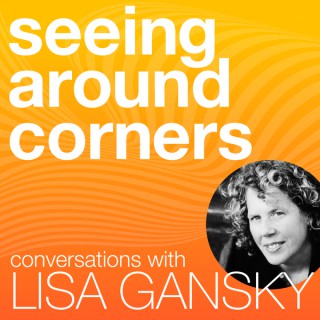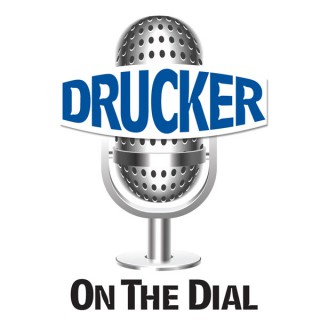Podcast appearances and mentions of lisa gansky
- 11PODCASTS
- 14EPISODES
- 58mAVG DURATION
- ?INFREQUENT EPISODES
- Jul 5, 2024LATEST
POPULARITY
Best podcasts about lisa gansky
Latest podcast episodes about lisa gansky
In today's competitive marketplace, creating a strong brand and developing a product or service that meets market demands is paramount for success. Entrepreneurs and small business owners need to understand the significance of brand development in resonating with their target audience and differentiating from competitors. Understanding Brand vs. Logo vs. Identity Before we proceed, let's address a common misconception about branding. Many people use the terms "brand," "logo," and "identity" interchangeably, but they are distinct concepts. What is a Brand? Your brand is the perception people have of your company. It encompasses your values, mission, and the emotional connection you create with your audience. Jeff Bezos, CEO of Amazon, once said, "Your brand is what other people say about you when you're not in the room." This highlights the importance of how your brand is perceived. The Role of a Logo: A logo is a visual representation of your brand. It's an essential part of your identity, but it's not the whole story. Think of it as the face of your brand. A well-designed logo can be memorable and convey your brand's essence at a glance. Crafting Your Business Identity: Identity includes all the visual and tangible elements that represent your brand. This encompasses your logo, typography, color palette, and even the tone of your communication. Your business identity is how you present yourself to the world, and it should be consistent across all touchpoints. Developing a Recognizable Brand with B.A.C.O.N. Creating a brand that appeals to your target audience involves a strategic approach. One effective method is using the acronym B.A.C.O.N., which stands for Brand, Audience, Competition, Origin, and Need. B – Brand: Your brand should reflect your company's core values and mission. It should tell a story that resonates with your audience. One successful example is Glossier, whose founder Emily Weiss said, "The most successful brands are those that create a compelling emotional connection with their audience." A – Audience: Understanding your target audience is crucial. Conduct market research to identify their preferences, needs, and pain points. This will help you tailor your brand and products to meet their expectations. Tools like surveys and focus groups can provide valuable insights. C – Competition: Analyze your competition to understand what they're doing well and where they fall short. This information can help you identify opportunities to differentiate your brand. Lisa Gansky, an entrepreneur, and author, aptly noted, "A brand is a voice, and a product is a souvenir." O – Origin: Your brand's origin story can be a powerful tool. Share why and how your business was founded. Authenticity resonates with consumers, creating a deeper connection. Bernard Kelvin Clive, a personal branding expert, emphasizes, "A strong brand is the most valuable asset your company can own." N – Need: Identify the specific need your product or service fulfills. This will guide your messaging and help you communicate your value proposition effectively. Peter Drucker, a management consultant, famously said, "The best way to predict the future is to create it." Creating a recognizable brand and developing a product or service that meets market demands is essential for the success of your business. By understanding the difference between your brand, logo, and identity, and leveraging BACON, you can build a brand that resonates with your target audience. Seeking professional help can further enhance your branding efforts, ensuring your business stands out in a competitive market. Remember, your brand is more than just a logo—it's the emotional connection you create with your audience. Invest time and resources into building a strong brand, and you'll reap the rewards in customer loyalty and business growth. www.MasterHappiness.com www.WhatsYourBacon.com
4105. 131 Academic Words Reference from "Lisa Gansky: The future of business is the "mesh" | TED Talk"
This podcast is a commentary and does not contain any copyrighted material of the reference source. We strongly recommend accessing/buying the reference source at the same time. ■Reference Source https://www.ted.com/talks/lisa_gansky_the_future_of_business_is_the_mesh ■Post on this topic (You can get FREE learning materials!) https://englist.me/131-academic-words-reference-from-lisa-gansky-the-future-of-business-is-the-mesh-ted-talk/ ■Youtube Video https://youtu.be/SSPBURjgtOM (All Words) https://youtu.be/tix2eINq9-Q (Advanced Words) https://youtu.be/dGFBsAW5Yps (Quick Look) ■Top Page for Further Materials https://englist.me/ ■SNS (Please follow!)
S04 Ep. 20 Bill Fischer and Lisa Gansky - A Situational Update on our Ecosystemic Future
In this season's final episode, we talk to Bill Fischer and Lisa Gansky about how our old ideas of what's normal are disappearing. There is a need to bridge the gap between old and emerging systems, encouraging exploration and experimentation to unlock our Ecosystemic Future. Bill Fischer has spent his entire career involved in innovation, from being a practicing development engineer in industry and government; to being an academic researcher, teacher and writer; to being involved in several startups. He is presently a Senior Lecturer at the Sloan School of Management, at MIT, and an Emeritus Professor of Innovation Management at IMD, in Lausanne, Switzerland. Lisa Gansky is a social provocateur, serial entrepreneur, angel investor, advisor, international keynote speaker and author of the bestselling book, “The Mesh: Why the Future of Business is Sharing”. Her work on trust, the sharing economy & innovation has been central in rethinking 21st century governance, business models & community dynamics. The challenges organizations are facing in adapting to rapid change show how traditional organizational structures are no longer working. To adapt to the changing landscape, a mix between AI, Web3 technologies and new ways to governance can allow for flexible and modular ways of organizing. New promises emerge through the overlap between organizations and software that can unlock new ecosystem potential where different players and customers come together, focusing on local relationships and embracing transience for more innovative solutions. Beyond all, it's important to keep up with optionality and dynamism, both key to the nature of Ecosystemic thinking: co-creation and increasing diversity and variance are going to be key in the markets of the future. These elements provide the backdrop for this Situational Update on our Ecosystemic Future. Key Highlights
My buddy Lisa Gansky in Manhattan joins me to co-host the Scottish Liberty Podcast and talk about the madness that is going on right now. Just when you think it's got as bad as it gets it gets worse.
A Beacon for Future Explorations - Wrapping up Season 1 with Bill Fischer and Lisa Gansky
In this episode, we have our two dear guests Lisa Gansky — the eternal entrepreneur, great thinker and our long term advisor — and Bill Fischer, professor at IMD in Lausanne with whom we’ve developed the very first Rendanheyi Masterclass based on Haier’s revolutionary organisational model and a partner in our long term research on the Entrepreneurial Ecosystem Enabling Organization.In our conversation, we wanted to pick their brains on the key theses emerging from the research for our upcoming 2020 Whitepaper, such as acknowledging marketplace pervasiveness, seeing a systemic shift happening towards health and redrawing the human development thesis to reverse the trend that machine development has long outpaced human development.Following an initial framing, Bill and Lisa take turns in providing amazing reflections on where the world seems to be headed, from an organisational, systems and cultural perspective and related to business ecosystems and innovation.Remember that you can find the show notes and transcripts from all our episodes on our Medium publication. Here are some important links from the conversation:See the previous Podcast episodes with Lisa and Bill> Checkpoint episode with Lisa Gansky: Ecosystems - between the “no more” and the “not yet”, https://stories.platformdesigntoolkit.com/checkpoint-episode-with-lisa-gansky-ecosystems-between-the-no-more-and-the-not-yet-c183d21257c4> Leadership as Architecting: Transforming Organisations into Thriving Ecosystems — with Bill Fischer. https://stories.platformdesigntoolkit.com/leadership-as-architecting-transforming-organisations-into-thriving-ecosystems-7-4af8dd0cf06c Other references and mentions:> Warren Bennis, 1998. The Temporary Society: What is Happening to Business and Family Life in America Under the Impact of Accelerating Change. https://www.amazon.com/Temporary-Society-Happening-Accelerating-Management/dp/0787943312 > Structural Shifts podcast by Aperture Hub, with Rita Gunther McGrath, Seeing Around Corners (#19): https://medium.com/aperture-hub/seeing-around-corners-19-ec64b2260337> Tessy Britton, “Universal Basic Everything” - .creating essential infrastructure for post Covid 19 neighbourhoods. https://medium.com/@TessyBritton/universal-basic-everything-f149afc4cef1> Simone Cicero, “An Entrepreneurial, Ecosystem Enabling Organization - What’s emerging from understanding Haier Group”. https://stories.platformdesigntoolkit.com/an-entrepreneurial-ecosystem-enabling-organization-c35eaf5acd9cFind out more about the show and the research at Boundaryless at www.platformdesigntoolkit.com/podcast Thanks for the ad-hoc music to Liosound / Walter Mobilio. Find his portfolio here: www.platformdesigntoolkit.com/music Recorded on July 1st 2020
Checkpoint episode with Lisa Gansky - Ecosystems: between the "no more" and the "not yet"
This is a “checkpoint” episode where we talk to Lisa about what we’ve been discovering so far in the research for the Whitepaper and get her valuable take focusing on the role of incumbents in adapting to a fast-changing world. She talks about the emerging space between the “no more” and “not yet”. In this in-between space where most of the potential to re-invent organizing seems to lay, ecosystems appear to be a candidate driver of transformation for incumbents, although questions abound regarding their maturity. > Follow Lisa Gansky on Twitter: https://twitter.com/instigating> Subscribe to “Instigate this” curated by Lisa: https://paper.li/instigating?edition_id=1f138460-82ac-11ea-a01c-0cc47a0d1605#/Some references mentioned in the show:> Marc Andreesen, “It’s time to build”, https://a16z.com/2020/04/18/its-time-to-build/> Slavoj Zizek on Coronavirus: "Things will not go back to normal", https://www.youtube.com/watch?v=XfWIMPredyI&feature=youtu.be> Ichak Adizes, Organisational Life Cycle: https://adizes.com/lifecycle/> Reporting 3.0 “Maturation Matrix”: https://medium.com/@r3dot0/introducing-the-r3-0-maturation-matrix-6652047a0ba8Music by liosound.Recorded on April 20th
EL CONSUMISMO SE HA VUELTO INVIABLE Y POCO RENTABLE; EN LA MAYORÍA DE LOS CASOS, ES MEJOR COMPARTIR LOS BIENES EN LUGAR DE POSEERLOS Y LUEGO DESECHARLOS Esta idea sobre Innovación Instantánea fue destilada de "La Malla" por Lisa Gansky. Este título es una introducción a la economía del acceso y a las plataformas compartidas que le han dado forma al mercado desde principios del 2010. Recomendamos todas las ideas de este libro a cualquier persona con la curiosidad de saber cómo funcionan negocios como Uber y Airbnb y a líderes con el interés de incursionar en la economía del acceso. Algo útil para dialogar Considerando tu industria o profesión ¿qué productos o servicios podrías permitirle a tus clientes compartir o intercambiar y cómo cambiaría esto la dinámica en tu negocio? ¿Te sirvió esta idea? Propágala para que más personas descubran de dónde vienen las buenas ideas. Suscríbete en ideasinfalibles.com o visita ideasinfalibles.com/premium para conseguir resúmenes completos.
Ep. 206. Fintech Insider: After Dark V - Part 2 San Francisco - Facebook Trust & Silicon Stereotypes
Sam and Doug sit down with Mike Sigal, VC at 500 Startups, Lisa Gansky, VC at Mosaic, Brit Morin, Founder and CEO of Brit + Co, Mark Jamison, Head of Innovation and Design at Visa, Kate Adamson, Head of Mortgage at Plaid, Tony Morosini, VP Banking at Sofi and Anatoly Kvitnitsky, Head of Growth at Trulioo. Sam takes the panel through the latest and greatest in news stories getting key insights into what's happening and what matters most. Including Mark Zuckerberg's appearance before Congress, Why nobody trusts Facebook, if equal pay is getting any closer and why Silicon Valley Stereotypes are just plain wrong. Guaranteed Fake News free and to teach you at least one thing you didn't already know! Subscribe so you never miss an episode, show us some love and leave a review on iTunes. Let us know your thoughts @FintechInsiders and join the discussion by signing up at www.fintechinsidernews.com Special Guests: Anatoly Kvitnitsky, Brit Morin, Doug Bobenhouse, Kate Adamson, Lisa Gansky, Mark Jamison, Mike Sigal, and Tony Morosini.
Best-Run Cities: Urban Matters – Part 2
Today's buzz: The city. Your city is a complex vital entity with the power to impact your local quality of life as well as national and global economies. How is your city running? Is innovation part of its DNA, spirit, budget and capabilities? The experts speak. Sean Patrick O'Brien, SAP: “What defines a best run city, how can you measure this, what do you benchmark against, and is this the same way citizens, businesses and officials make such a judgment?” Meghan Cook, Center for Technology in Government, Univ. at Albany, NY: “The mesh is an emerging business model based on a network enabled sharing – on access rather than ownership ... where consumers have more choices, more tools, more information, and more peer-to-peer power to guide the choices” (Lisa Gansky, author of The Mesh: Why the Future of Business is Sharing). Cindy King, City of Edmonton: “Make sure what you do is a product of your own conclusion (Jim Rohn). Join us for Best-Run Cities: Urban Matters – Part 2.
Best-Run Cities: Urban Matters – Part 2
Today's buzz: The city. Your city is a complex vital entity with the power to impact your local quality of life as well as national and global economies. How is your city running? Is innovation part of its DNA, spirit, budget and capabilities? The experts speak. Sean Patrick O'Brien, SAP: “What defines a best run city, how can you measure this, what do you benchmark against, and is this the same way citizens, businesses and officials make such a judgment?” Meghan Cook, Center for Technology in Government, Univ. at Albany, NY: “The mesh is an emerging business model based on a network enabled sharing – on access rather than ownership ... where consumers have more choices, more tools, more information, and more peer-to-peer power to guide the choices” (Lisa Gansky, author of The Mesh: Why the Future of Business is Sharing). Cindy King, City of Edmonton: “Make sure what you do is a product of your own conclusion (Jim Rohn). Join us for Best-Run Cities: Urban Matters – Part 2.
“The distribution centers of the future are our closets and garages,” says Andy Ruben, co-founder of sharing start-up Yerdle. Entrepreneurs like Ruben are tapping into social media circles as a way to connect members to a wealth of sharing options. “Data, in many ways, is the gateway drug to the sharing economy,” says Lisa Gansky, Author of “The Mesh”. Other entrepreneurs like Billy Parish, Co-Founder and President of Solar Mosaic, are “unlocking the ability of individuals to participate in the investment process.” Crowdfunding seems to be the next wave of the sharing economy with opportunities ranging from peer-to-peer investment and Solar Mosaic’s own solar investment projects. A conversation on the exciting possibilities of a growing sharing economy. This program was recorded in front of a live audience at The Commonwealth Club of California on March 5, 2013
Host Phalana Tiller talks with professor and author Sherry Turkle about her book, Alone Together. She also interviews Lisa Gansky, entrepreneur and writer of The Mesh. The conversations explore how connectedness through technology is impacting our lives and our organizations.
WHAT'S A MESH BUSINESS WITH LISA GANSKY – PODCAST EPISODE #104
Internet Marketing: Insider Tips and Advice for Online Marketing
There's no avoiding it Lisa Gansky is someone who knows what she's talking about when it comes to digital business See acast.com/privacy for privacy and opt-out information.
Why the Future of Business is Sharing (Lisa Gansky)
Traditional businesses follow a simple formula: create a product or service, sell it, collect money. But in the last few years a fundamentally different model has taken root — one in which consumers have more choices, more tools, more information, and more peer-to-peer power. Pioneering entrepreneur Lisa Gansky calls it the Mesh and reveals why it will soon dominate the future of business. Mesh companies create, share and use social media, wireless networks, and data crunched from every available source to provide people with goods and services at the exact moment they need them, without the burden and expense of owning them outright. Gansky reveals how there is real money to be made and trusted brands and strong communities to be built in helping your customers buy less but use more.















